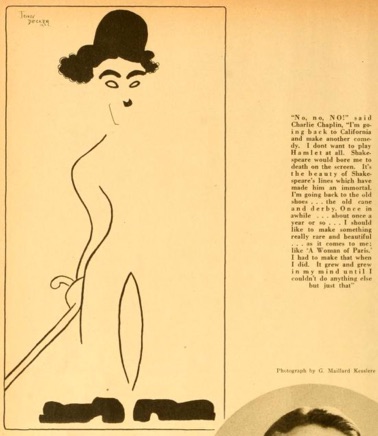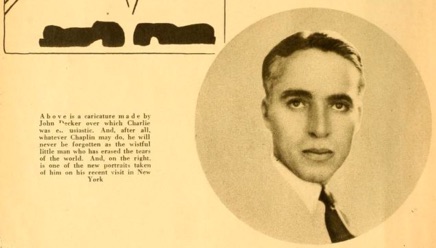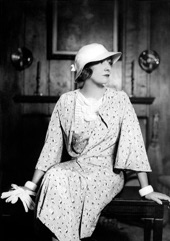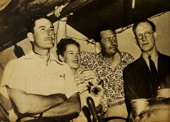The Gold Rush 1924 1925 1926 next previous
The Gold Rush Clippings 56/363
Gladys Hall/Adele W. Fletcher, Motion Picture, N. Y., Feb. 1924.
Gladys Hall, undated, Margaret Herrick Library, Academy
of Motion Picture Arts and Sciences
& On board the „Zacca“ for first postwar expedition: Errol
and Nora Flynn, artist John Decker and Errol‘s
father, scientist Thomas Flynn. (...) Modern Screen, April 1947
„No, No, NO!“
Editorial content. Cartoon by John Decker.
„Above is a caricature made by John Decker over which
Charlie was enthusiastic. And, after all, whatever
Chaplin may do, he will never be forgotten as the wistful little
man who has erased the tears of the world. And,
on the right, is one of the new portraits taken of him on his
recent visit in New York.“
Photograph by G. Maillard Kesslere. Charles Chaplin.
,No, No, NO!‘ said Charlie Chapin. ,I‘m going back
to California and make another comedy. I don‘t want to play
Hamlet at all. Shakespeare would bore me to death
on the screen. It‘s the beauty of Shakespeare‘s lines which
have made him an immortal. I‘m going back to the
old shoes... the old cane and derby. Once in awhile... about
once a year or so... I should like to make something
really rare and beautiful... as it comes to me: like A Woman
of Paris. I had to make that when I did. It grew and
grew in my mind until I couldn‘t do anything else but just that.“
We interview Charlie Chaplin
A Playful Playlet in One Act and Five Scenes
The Cast
Charlie Chaplin – Whom all the world knows
We – Gladys Hall and Adele Whitely Fletcher
Such supernumeries as: Hotel clerks, audience at the
Lyric Theater, page boys, telephone operators,
publicity men, elevator experts, Charlie‘s Japanese valet,
who should be in the diplomatic service, et cetera.
SCENE I IS THE LYRIC THEATER. – It is the New
York premiere of A Woman of Paris.“
„Gladys Hall (coaxingly): Aren‘t we going to interview him?
Huh? Huh?“
Adele Whitely Fletcher (with deliberation... perhaps she
was planning a single interview, who knows?)
Maybe...“ (...)
„Gladys Hall: I have a new dress and everything...“ (...)
„SCENE II. – The lobby of the Ritz-Carlton. Two days
later. It is eleven o‘clock and Gladys Hall and Adele Whitely
Fletcher enter, yawning. Of course they are working
girls and all that. Still... Adele Whitely Fletcher requests
the number of Mr. Chaplin‘s suite with something of
an air de luxe.“ (...)
„Adele Whitely Fletcher (optimistically, as it develops):
Room 423, please...“
„Adele Whitely Fletcher: Miss Hall and Miss
Fletcher to see Mr. Chaplin by appointment. (Pause)
„Adele Whitely Fletcher (aggrieved): But we had an
appointment. He hasn‘t risen yet?“ (...)
SCENE III. Same as Scene II. Two o‘clock
in the afternoon.“ (...)
„Adele Whitely Fletcher (and there is marked doubt in
her tone): Room 423, please... (Pause.)
„Adele Whitely Fletcher: He hasn‘t risen yet?
Well, but... (Pause.)
Adele Whitely Fletcher: Very well, then, we‘ll be up in half
an hour...“
„SCENE IV.“ (...)
„Gladys Hall (with seeming irrelevance): In your
picture, A Woman of Paris, was your heroine in love with
both men?
Charlie Chaplin (as impersonally as tho he were
discussing the Einstein theory as applied to the planet of
Mars): No, I don‘t think so. I don‘t think a woman
could love that boy from the country after she had known
intimately a man of the other sort. A man of his
sophistication, polish, charm. For the boy I thought she
felt a sentimental interest. She felt that she should
be in love with him; that it was the thing to do. But a woman
loves first the man who makes her comfortable.
After that she can afford to indulge in sentiment...
Adele Whitely Fletcher: Don‘t you think that women are
more sentimental than men?
Charlie Chaplin: No. You know they‘re not. Men are
the great sentimentalists. Women are more direct,
too. A woman sees something she wants and goes straight
after it. She generally gets it, too.“ (...)
„Adele Whitely Fletcher: You didn‘t have a bit of trouble
with the censors, did you?
Charlie Chaplin: No you see, in the first place, the
ending of the picture salved anything like that.
And then, too, there is really nothing in the entire picture
that could offend a child when you come to think
of it. Only the sophisticated person, the person thoroughly
in the knowledge of a certain type of life and what
it means, would be sure of what he or she was seeing.
I feel, that is, I tried, to give the lives of those few
people as I saw them, as they would be lived, and with
offense to none.
(Adele Whitely Fletcher and Gladys Hall now
reluctantly arise to go. Especially in view of the fact that
the valet has been answering the ‘phone at intervals
for hours and now, rather hoarse, informs Mr. Chaplin that
someone is awaiting him in the anteroom.)
Charlie Chaplin (gallantly): Don‘t hurry. I‘ve lots
more to say to you. And I‘m really sorry there was any
misunderstanding about our appointment.
Really.“ (...)
„SCENE V. – Fifth Avenue. It is now five-thirty. The
interviewers are discovered threading their aimless ways thru
the crowds.“ (...)
Six photos, two drawings.
See also Hall/Fletcher, We Interview Pola Negri,
Motion Picture, Jan. 1923.
Redaktioneller Inhalt
The Gold Rush 1924 1925 1926 next previous




